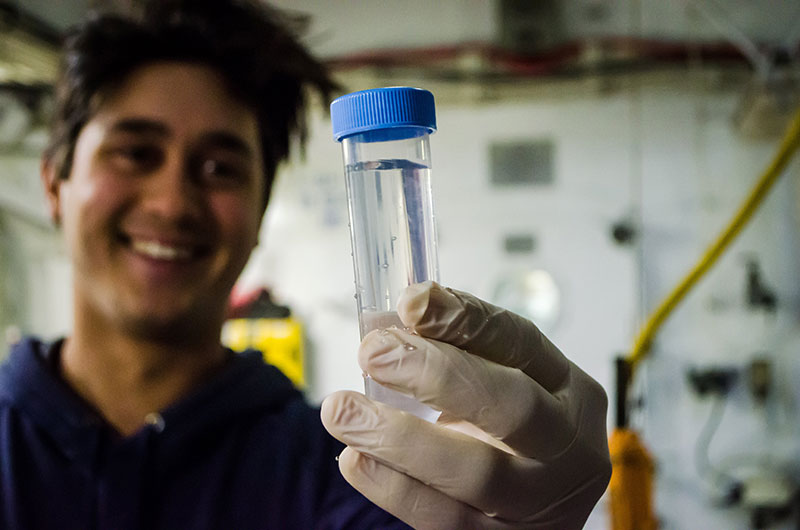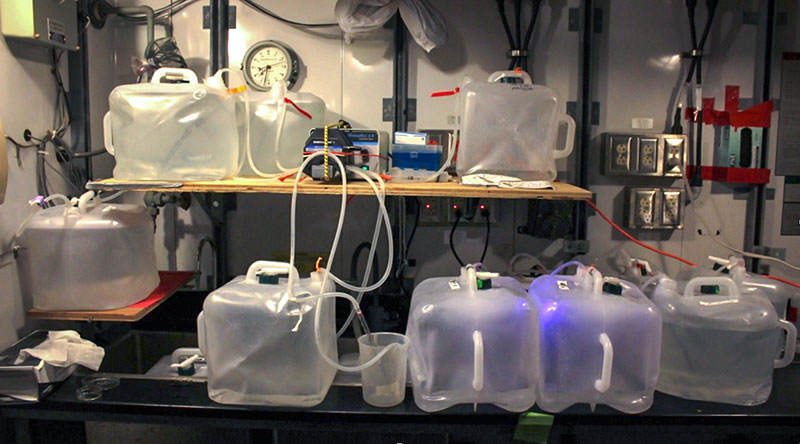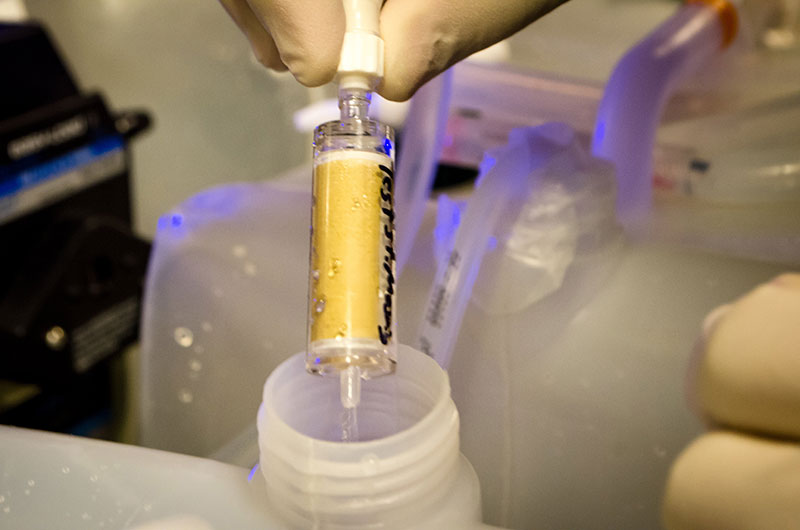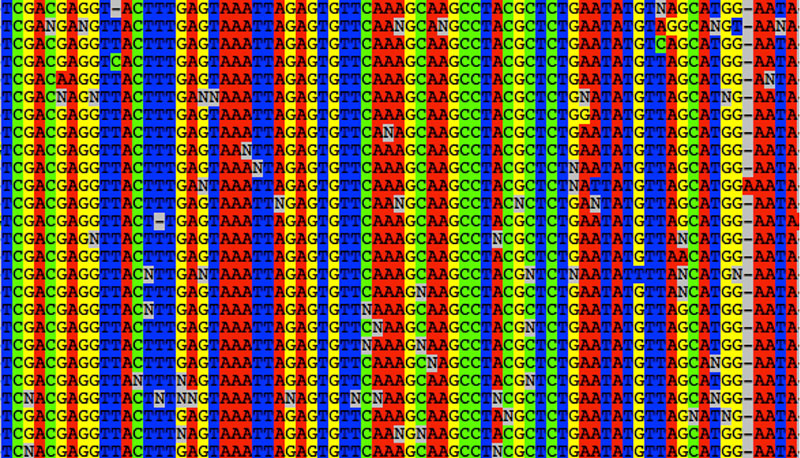
By Brian Ulaski, Graduate Student, University of Alaska Fairbanks
July 31, 2016

Brian Ulaski holds up a water sample from the CTD that he will filter for microbes. Image courtesy of Caitlin Bailey, GFOE, The Hidden Ocean 2016: Chukchi Borderlands. Download larger version (3.5 MB).
Studying microbial oceanography has altered how I interpret the living world around me. Take a look around you, wherever you may be – if bacteria were instantly illuminated under some sort of microbial black light, you’d witness the ever-presence of the unseen majority.
Microorganisms, or microbes, are ubiquitous in nature while conducting essential tasks that are beneficial to the global ecosystem, e.g., as primary producers, converters of inaccessible chemicals to bioavailable products, and degraders of organic material. The general term ‘microbe’ encompasses bacteria, archaea, single-celled eukaryotes, and viruses. Within the oceans, microbes dominate when it comes to total biomass and abundance of individuals. The generation times of these microbes are short, allowing them to rapidly adapt to environmental changes – henceforth their importance to the study of changing ocean conditions. A better understanding of their current diversity within the Arctic environment is vital to future studies of potential changes to the sensitive system from an ecological perspective.

Seawater collected from a CTD-cast is pumped through 0.22µm pore-sized filters to concentrate microbial cells in this filtration station. Image courtesy of Brain Ulaski, UAF, The Hidden Ocean 2016: Chukchi Borderlands. Download larger version (385 KB).
During this expedition, we filtered upwards of 2,000 liters of seawater, which will ultimately be narrowed down to a squint-worthy volume of 100 µL (about five drops) from which genetic material (DNA) will be isolated.
My goal is to take the concentrated DNA from Arctic seawater, sequence it, and analyze it in parallel with a suite of environmental measurements that were obtained concurrently (see ‘One Instrument for All’ by Pete Shipton for more details on the instruments used to obtain water samples and in situ physical data). These data will be added to those from two previous Arctic research cruises, to the Barents and Chukchi Seas. The oceanographic drivers are the same among the different regions (i.e., temperature, salinity, nutrient concentration/availability), but their characteristics (i.e., warm, cold, brackish, fresher, nutrient-rich, nutrient-poor) are distinguishable among Atlantic, Pacific, and Arctic water masses. These differences likely yield distinguishable microbial communities and are responsible for their vertical distribution within the water column and horizontally across Atlantic-fed versus Pacific-fed regions of the Arctic Ocean.

This Sterivex filter is catching the viruses that can be found in the seawater from the CTD-cast. Image courtesy of Caitlin Bailey, GFOE, The Hidden Ocean 2016: Chukchi Borderlands. Download larger version (3.3 MB).
Bacterial and single-celled eukaryotic DNA from the Barents and Chukchi Seas have already been extracted. Polymerase chain reactions (PCR) were employed for targeted sequencing of both the 16S (prokaryote) and 18S (eukaryote) ribosomal RNA genes, which are highly conserved and act as ‘barcodes’ for identifying members within a community. Therefore, identifying these shorter barcodes provides a means by which we can garner information on the diversity that exists within a given community. Analysis of the diversity and distribution of Arctic marine microbes will lay the groundwork for future studies of these tiny, yet biogeochemically paramount organisms. Accordingly, this project aims to shed light on the vast diversity of bacterial and protist communities within the gateways to the Arctic Ocean that are directly influenced by Atlantic and Pacific waters.
It is pleasantly challenging to wrap my head around the notion that my entire thesis is contingent upon the proper handling of those five drops of liquid. With a tiny volume of water and a small window into the microbial world, this information will contribute to elucidating the bountiful diversity of microbes within the pelagic realm of the Arctic Ocean.

An 18S ribosomal RNA gene alignment derived from an Arctic seawater sample. Each row denotes a separate sequence barcode. Image courtesy of Eric Collins, UAF, The Hidden Ocean 2016: Chukchi Borderlands. Download larger version (807 KB).